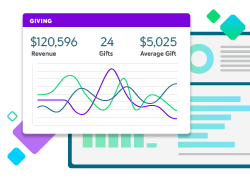Engagement Tools to Prepare Your Board for a Capital Campaign

If you’re reading a blog post with the words “capital campaign” and “board” in the headline, you might be spiraling through questions that are keeping you up at night (hopefully, it’s not 2 a.m.):
- Did we set appropriate capital campaign goals with our board?
- Is our board on track for the public phase?
- How can we get our board more involved?
Whether you’re already riding the momentum of an exciting campaign or just considering the planning phase, know you have access to the right engagement tools and tips to prepare your board for a successful capital campaign.
The Importance of Ongoing, Consistent Engagement
First point: Board engagement should start long before your capital campaign is even a twinkle in your organization’s eye. I’m likely preaching to the choir here, but let’s make sure we’re not reaching out only when we need something, right?
Position your organization for even greater success by having a strategic donor engagement cycle in place—for all donors, not just board members. So, what does this look like? Key elements include:
- Consistent communication about your mission and its impact (including visually appealing at-a-glance infographics)
- Tailored “asks” by segment and by demonstrated ability to give
- Heartfelt thank-you notes and recognition for donors’ commitment to your cause
But What About My Board’s Engagement?
Minor course corrections can make all the difference when it comes to ongoing board engagement. There’s never a bad time to make improvements (but doing so in the lead-up to a capital campaign is perhaps the best time of all.) Here are some key touchpoints:
- Implement a “board roles and responsibilities” checklist. This serves as your main point of reference for board expectations and for your one-on-one meetings.
- Incorporate a “Mission Moment.” Make it a standing agenda item at every board meeting.
- Ensure your members know where to find important board information. (Hint: Don’t make them scroll through their inboxes—more on that below!)
- Create board trios or a board buddy system. Remember your first day on the (insert activity) team? Engagement grows significantly when someone new is warmly welcomed and immediately feels connected to fellow board members. Assign team-building triads or duos at any time, whether it’s all board members at once or when you onboard a new member.
- Hold an annual board retreat. This dedicated “non-meeting” time goes a long way in solidifying board relationships. A half-day or an 8-11 a.m. breakfast session keeps costs low and allows members to get back to their offices by lunchtime.
The stronger your foundation for board involvement and understanding of your mission, the more likely you will head into your capital campaign from a position of strength.

Bringing It Together: Why Your Board’s Participation Is So Crucial
No matter if your organization is a regional food bank, a housing nonprofit, or an independent school, your board’s responsibilities are defined by three main legal fiduciary duties: care, loyalty, and obedience.
Given the nature of a capital campaign, your board will be asked to approve operating budgets and your overall capital campaign budget. Since your board is already responsible for setting long–term strategic goals and addressing priority issues, this is an opportunity to reinforce how your campaign supports your organization’s strategic goals.
The old saying “perception is reality” rings true here: Board members need to embody knowledge, confidence, and pride during all three phases of your capital campaign as they speak about the fundraising effort to support and expand your mission.
Capital Campaign Phases: Opportunities to Build Board Buy-In
Each phase of your capital campaign—the planning (or feasibility) phase, the quiet phase, and the public phase—provides specific needs and opportunities for board engagement.
It is vital that you set aside time for an orientation about the capital campaign process and what board members can expect. Each member’s skills, network, and resources offer a unique path for support.
So, let’s segue into how to best connect with board members throughout the process.
1. The Planning Phase
During this phase, your board can offer expertise in helping to project your campaign expenses. Board members should participate in feasibility study interviews to gauge interest in participating, levels of giving, and ability to give.
Board members should take on key campaign leadership roles in partnership with your advancement or development director. Planning and Steering Committees provide more defined arenas for board participation during this phase. Board members with communications expertise can be particularly helpful during this time to help develop messaging for email, direct mail, and your campaign website.
2. The Quiet Phase
During this phase, there are several opportunities to galvanize and engage your board. As key funding commitments are received, members should gain increased confidence in the campaign and feel like key players on the team. This is where members’ unique strengths and skills can shine. For example, a member may want to host an intimate gathering (donor event) to share information about the campaign and your mission.
By now, you should have a defined gift range chart to demonstrate the impact of various giving levels. You should also be confident that your campaign messaging is formalized and professional. During this phase, some members might be more comfortable making introductions rather than hosting, so it’s important to note the value in their assistance with corporate connections, challenge grants, or gift-matching opportunities.
3. The Public Phase
In launching this final phase, timing is key. It should be directly tied to your progress and defined metrics. If you’ve budgeted for a kickoff event (or plan to), board members can often be great connectors to venues, key sponsors, or noteworthy attendees to drum up even more momentum. And this is where peer-to-peer fundraising comes in as a way for board members to efficiently reach their networks with your campaign’s message and raise more money for your mission.
Help board members become incredible fundraisers: Learn more.
3 Reasons Your Board Is Essential to Your Capital Campaign
Here’s the short list of why you need your board on board to have a successful capital campaign:
- They’re often your first and largest donors: While there’s no “magic percentage” for your board’s collective giving goal, it is typically significant, usually 20-50%. But to maximize this amount, it’s important to have your 1:1 conversation early in the planning phase so there’s time and space for board members to learn about the campaign and feel comfortable sharing a giving range.
- They’re your best ambassadors: Board member confidence in your organization and its mission is essential. Their enthusiasm to evangelize your cause is tied directly to how well educated they are about your mission and your impact. Make sure they have access to the data and details that will help them tell your mission’s story.
- They know how to get things done. There’s a reason why board members march into their local legislator’s office on behalf of your nonprofit. When a board member speaks passionately about your organization, the message lands differently than when it comes from a fundraising director.
Tools for Engagement
To grow board buy-in, participation, and accountability before you launch a capital campaign, start with three essential engagement tools and upgrades.
1. Provide a Board Portal
A good board portal should be affordable and provide a central location for board members to see all their relevant board and committee meetings, information, and communication.
A board portal can ensure members have access to key campaign updates 24/7, with access from any device, including a mobile app. You can even track who’s reading updates to get a handle on engagement at each stage.
A secure board portal provides access to and stores all campaign-related committee meetings and documents, and it should integrate with members’ digital calendars.
Investing in software? Learn how to gain board approval for new tech.
2. Optimize Your Fundraising Software
Chances are there’s functionality to support your capital campaign already available on your existing fundraising platform. If you’re unaware of it, reach out to your vendor.
For example, Blackbaud Raiser’s Edge NXT integrates with the board portal solution, BellesBoard, where your “Lists of Lists” can be easily imported to an intuitive platform for board member access.
Key to this integration is the ability for a campaign director (and others on the fundraising team) to assign members specific prospects or donors and assign relationship-building tasks to grow campaign awareness and giving. In addition, board members have access to a clear view of their assigned prospects and to a key fundraising staffer, so they feel supported in their efforts.
3. Add Progress Tracking
Given the length and complexity of a capital campaign, it is important that staff and committee members know where to look to assess progress. Just as you might utilize a roadmap to keep your strategic planning process on track, there should be a similar point of reference for your capital campaign, making it easy for board members to report on their progress and for you to clearly communicate what is being asked of them.
If you have an effective model in place to track progress on strategic plan goals (such as a strategic plan report card), consider using this to incorporate your campaign metrics. Regardless of the format that works for your organization, this information should be housed in an existing project management tool or your board portal, so that members have easy access from anywhere.
Takeaways for Your Capital Campaign
You shouldn’t attempt to do everything all at once. Plan and build your strategy over time. Start by bolstering your capital campaign effort with intuitive technology tools designed to help both fundraising staff and board members alike. And strive for one source of truth as it relates to campaign progress, related tasks, and overall accountability.
The Nonprofit CRM Built for Fundraisers
Find out how Blackbaud’s Raiser’s Edge NXT® fits your organization.

 Free Resource
Free Resource
